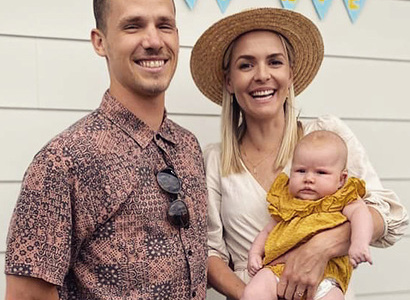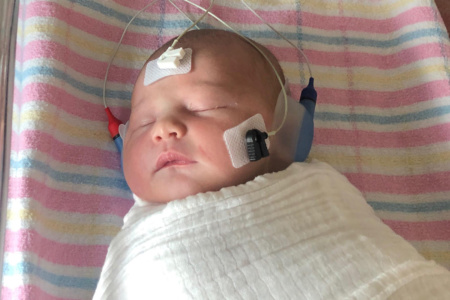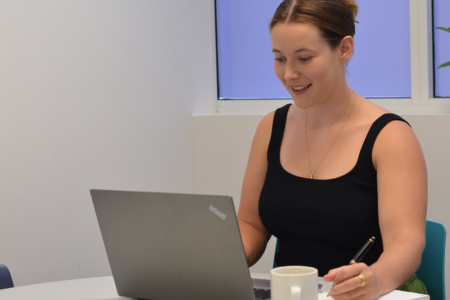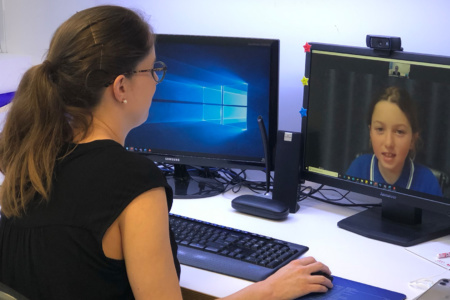Navigating various phone calls and appointments following a child’s diagnosis of hearing loss can feel daunting and challenging. Through a combination of world-class hearing technology and our specialist type of speech pathology support (listening and spoken language therapy), kids can grow up hearing and speaking just like their typically hearing siblings and friends.
We are currently experiencing internet and phone issues in some of our centres. For all enquiries, please contact mail@hearandsay.com.au.
My child has a hearing loss
Information about what to expect next
Learning to hear and speak
Most children with hearing loss who receive specialist intervention prior to 12 months of age develop age-appropriate speech and language skills by the time they are three years old.1
Hear and Say is here to support you
The journey: hearing loss diagnosed at birth
Everyone’s journey with hearing loss is different. Below are the common steps you may take if you’re in Queensland:
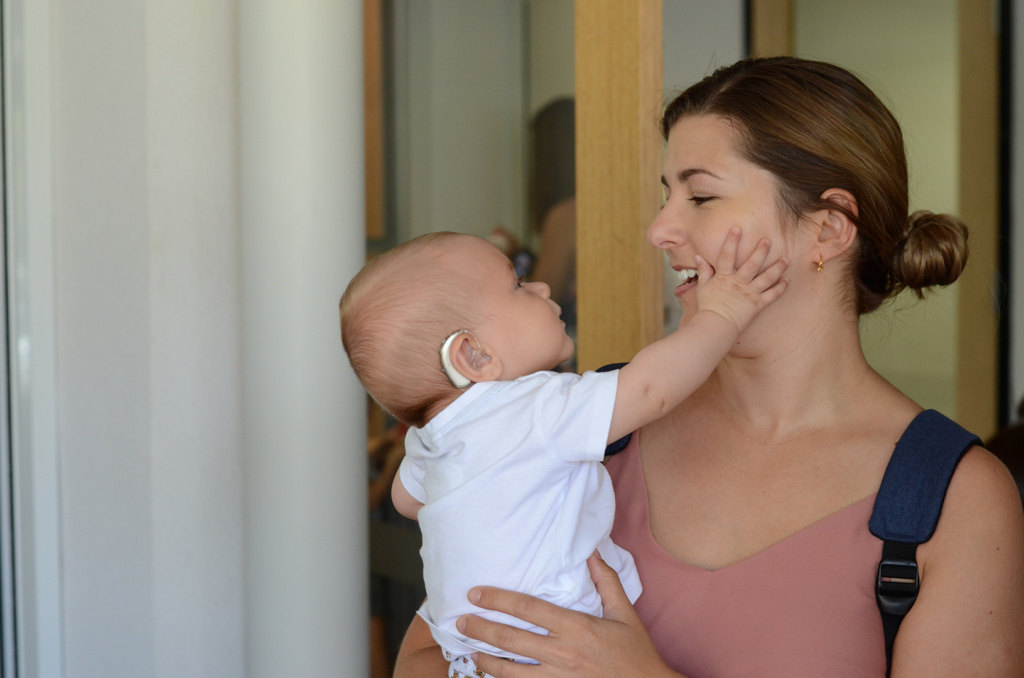
Free newborn hearing screening is offered to babies across all hospitals – typically, within one to two days of birth. If a refer result is received, you will be referred to the Healthy Hearing Program for your baby to have a full hearing test.
A full audiology assessment will provide confirmation of hearing loss. The test is called an Auditory Brainstem Response (ABR) and can be done at Hear and Say. This test usually takes place within two weeks for babies with a suspected hearing loss in both ears following a bilateral refer, and within six weeks for babies with a suspected hearing loss in one ear following a unilateral refer.
An ENT specialist can provide specialist medical care and arrange other assessments including genetic consultation and scans of the ear. If relevant, they will also provide advice and discuss options around fitting of hearing aids and cochlear implant assessments or evaluations.
Hearing Australia is a government service which provides hearing aids for all young children and adults under 26 years of age.
A paediatrician will look at any medical and developmental concerns as well as explore the potential cause of a child’s hearing loss.
This Queensland Health program oversees the journey from hearing screening through to diagnosis and enrolment in early intervention programs. The service where your child has the diagnostic hearing test is part of the program and, if your child has trouble hearing, or a hearing loss is diagnosed, they will refer you to the Childhood Hearing Clinic.
This one-stop-shop clinic is where families whose child is diagnosed with a permanent hearing loss are offered collaborative support and management with a range of health care professionals. You will meet a Family Support Facilitator. Your family support facilitator will provide information about communication options, early intervention, support services and financial assistance. There are two Childhood Hearing Clinics in Queensland – Queensland Children’s Hospital and Townsville University Hospital.
You will probably hear about Early Intervention programs from your Family Support Facilitator. An Early Intervention program, such as Hear and Say, supports your child with highly specialised speech pathology services (Listening and Spoken Language therapy) to teach them to listen and speak. Hear and Say can also liaise closely with Hearing Australia in the management of your child’s hearing aids. Hear and Say also has an audiology program which provides specialised management of implantable hearing devices such as cochlear implants.
The NDIS is a government insurance program that provides direct funding for people with disability to access support and services. Hear and Say is a registered NDIS provider and most of our programs and services are eligible for NDIS funding.
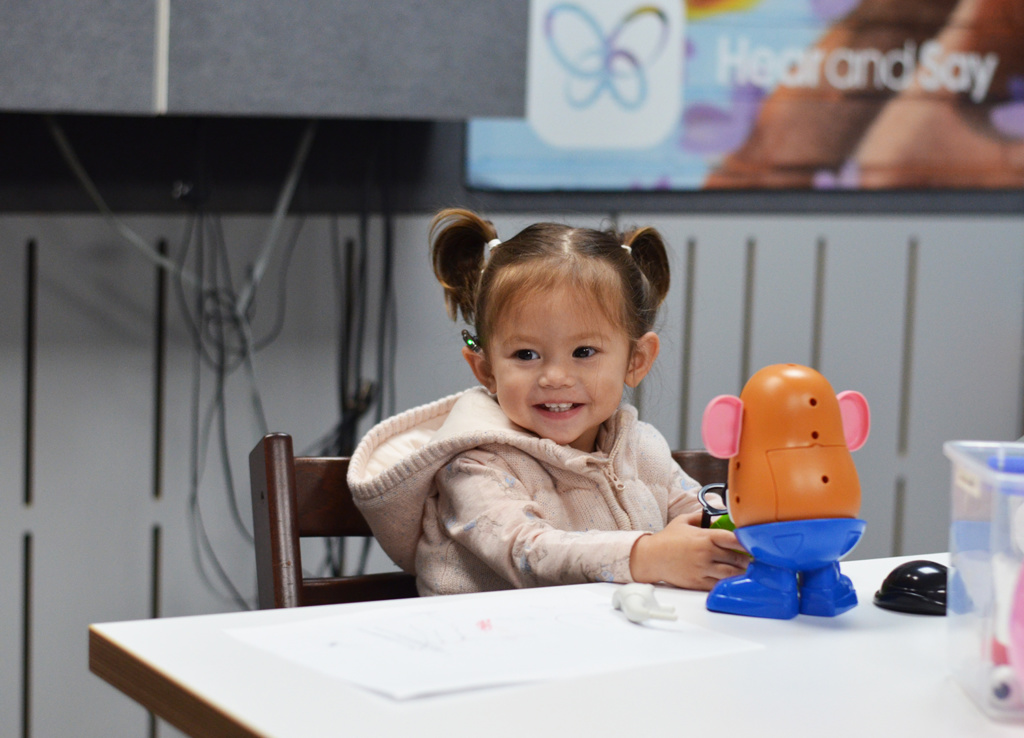
The journey: hearing loss diagnosed as a toddler, at preschool or school
If your child is not diagnosed with hearing loss at birth, and you find out they have a hearing loss later on, the journey is a little different. These are some of the steps you may take:
- Hearing test, click here for more information
- Ear, Nose and Throat (ENT) specialist
- Hearing Australia, click here
News
Newborn Hearing Screening: Being Referred
Specialist speech and development therapy
Hear and Say, offers a specialist type of speech therapy teaching children to listen and speak using their hearing devices so they can go on to reach milestones like their siblings or friends. Our qualified therapists work closely with our audiologists to ensure hearing devices are fitted and performing at their best. They work on the development of children’s listening, spoken language and speech skills as well as the development of skills across literacy, cognition and social interaction. The ultimate goal is for each child to reach milestones at the same rate as their typically hearing siblings and friends.
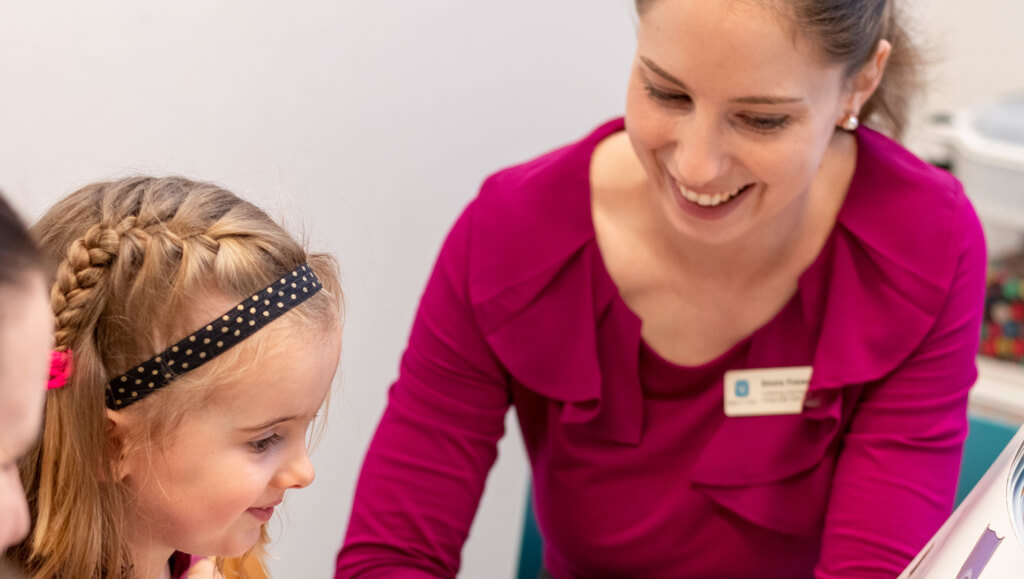
“We wanted to give Eden the same options as any kid gets, and have everything available to her. It was then incredibly comforting to come to Hear and Say and know they would be there every step of the way. There was a clear pathway ahead for her to be able to hear and speak.”
Liam, father to one-year-old, Eden
It’s important that you choose what is right for you and your family.
Hear and Say can support you step-by-step.
Contact us for more information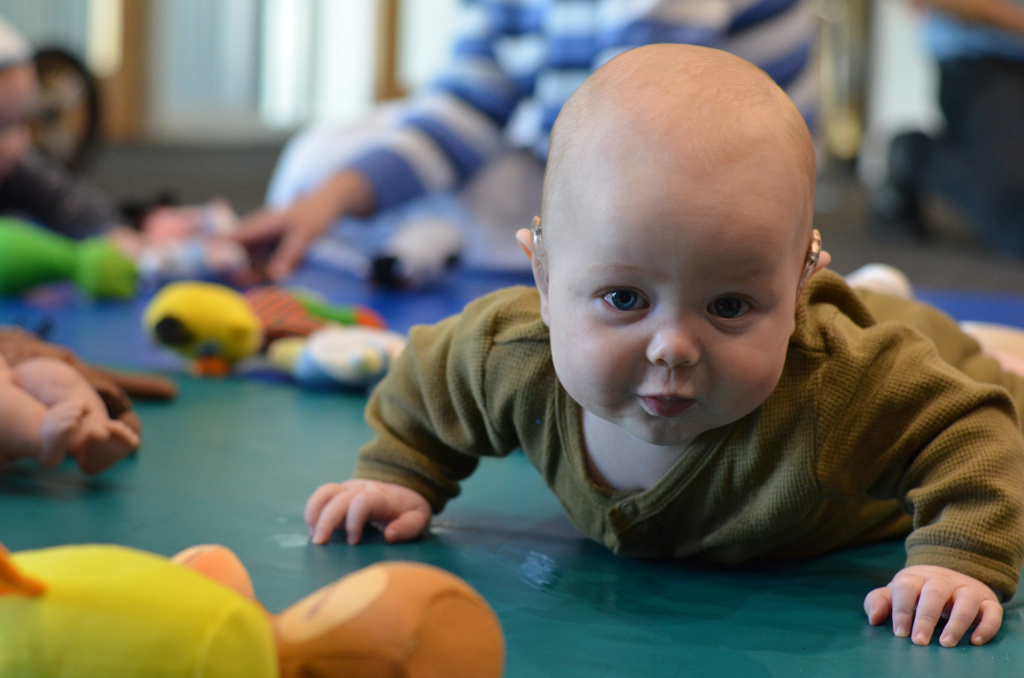
What caused my child’s hearing loss?
A child’s diagnosis of hearing loss often leaves families wondering what has caused it. In some cases, it is linked to medical conditions, but in many cases there is no known cause. Your audiologist and ENT specialist may suggest testing to investigate this further. There are many different causes of hearing loss, but all will arise from either a congenital or acquired condition.
Congenital hearing loss
When a baby is born with hearing loss it is known as congenital hearing loss. This could be caused by factors like genetics, medical conditions including virus or illness, or premature birth.
Acquired hearing loss
When a baby or child has hearing loss that has happened after birth, it’s known as acquired hearing loss. Acquired hearing loss can happen during birth or any time after birth.
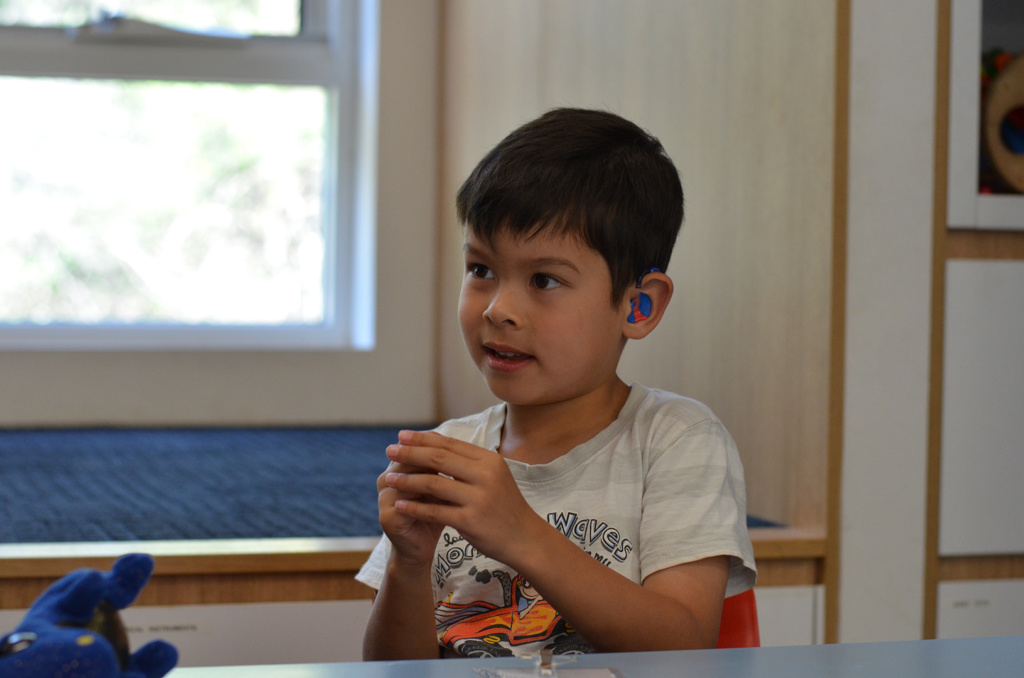
Types of hearing loss
The most suitable type of hearing device for a child is dependent on several factors, including type and severity of hearing loss.
Conductive Hearing Loss
Hearing loss resulting from an issue with the middle ear and/or outer ear.
Sensorineural Hearing Loss
A permanent type of hearing loss due to damage to the hair cells within the cochlea (inner ear) and/or to the auditory nerve. Once developed, sensorineural hearing loss is a condition you will have for the rest of your life.
Mixed hearing loss
A combination of both sensorineural hearing loss and conductive hearing loss.
Temporary hearing loss
Sometimes children will experience a hearing loss that comes and goes. Whilst it may be only temporary, this hearing loss can impact their speech and language development and the reaching of key milestones. Glue ear and otitis media are common ear infections impacting young children, with research suggesting 75 percent of children will have at least one bout by their third birthday.
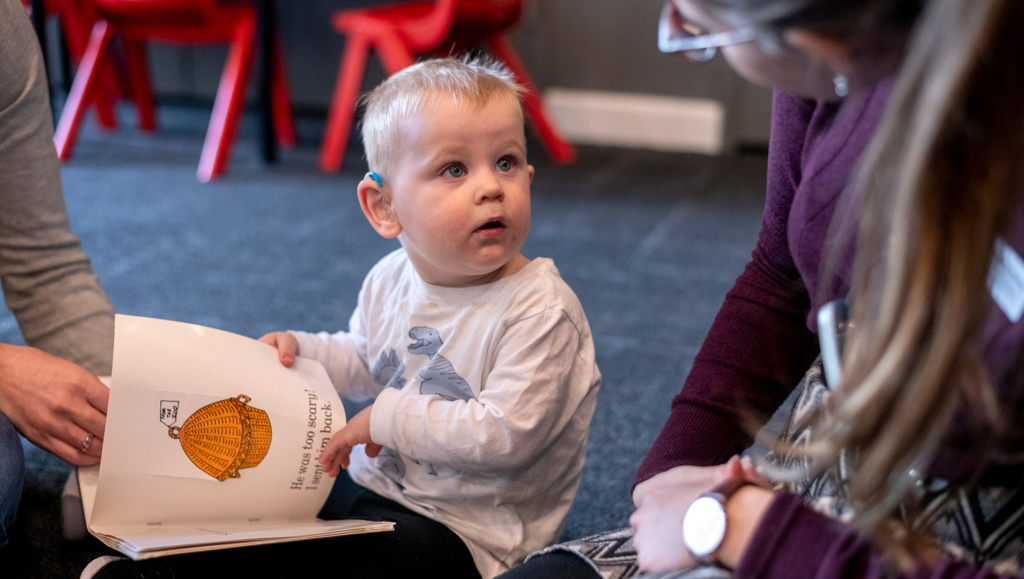
Degrees of hearing loss
Hearing loss is also categorised according to the level or hearing, including:
Mild hearing loss
Difficulty hearing soft voices, and speech at a distance or in background noise. Usually 21 to 45 decibels (dB).
Moderate hearing loss
Everyday communication is impacted, especially in group situations or without visual cues. Increased listening effort and concentration is required, often leading to fatigue. Moderate hearing loss falls within 46 to 65 dB.
Severe hearing loss
Understanding everyday speech is a significant struggle. Speech sounds needs to be very loud to be heard. The high levels of concentration required to try to understand speech results in noticeable fatigue. Severe hearing loss is within 66 to 90 dB.
Profound hearing loss
Hearing loss is so extreme that only excessively loud speech or loud sounds may be heard. Profound hearing loss is anything greater than 91dB.
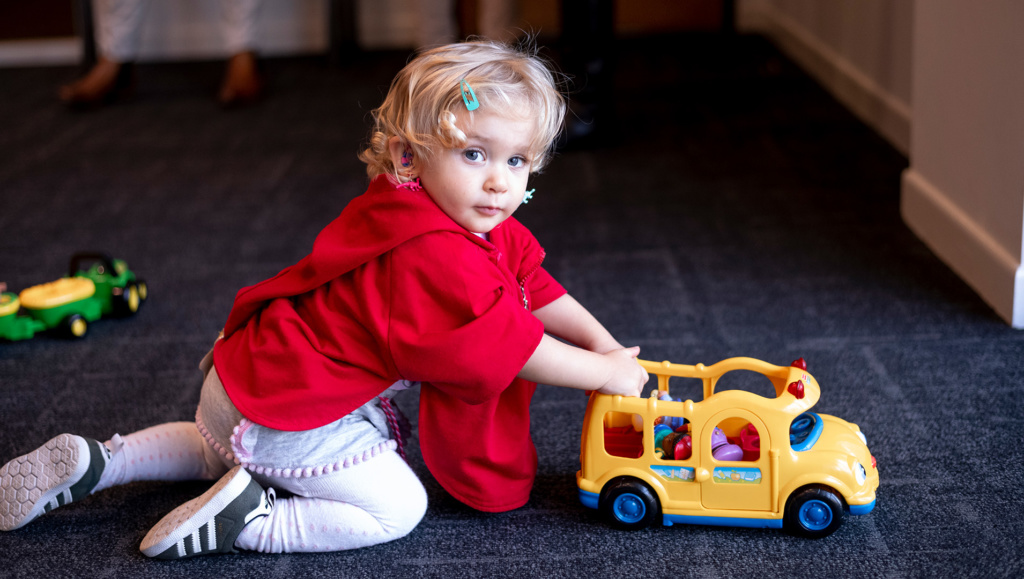
Treatments for children’s hearing loss
For children born deaf or hard of hearing, every day without sound can limit their potential. The early years are crucial to give children the best opportunity to grow up learning to hear and speak, just like their siblings and friends. Hearing Australia reports that children who use hearing aids or cochlear implants as soon as possible after they are diagnosed have better speech and language than those who are fitted later.
What actions can be taken to overcome hearing loss challenges?
Depending on the type and degree of hearing loss a child has, hearing technology such as hearing aids, cochlear implants or bone anchored hearing aids, as well as specialised speech therapy, is recommended.
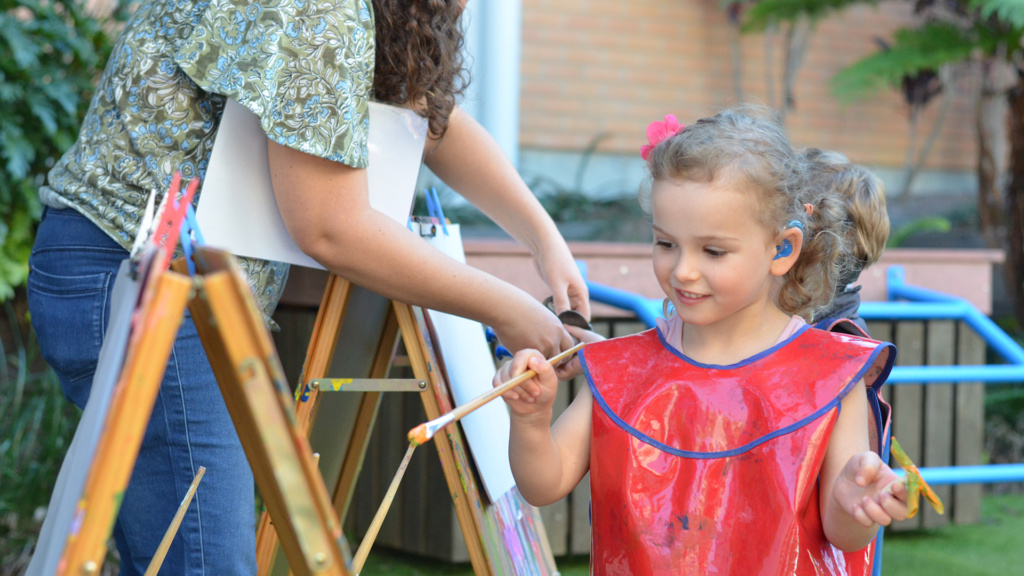
Hearing aids
Hearing aids make sounds louder, and are most suitable for children (and adults too) with mild, moderate or moderately severe hearing loss. In many cases, babies identified with a hearing loss are fitted with hearing aids as young as six weeks old, even if they are undergoing evaluation for implantable hearing devices.
Hearing Australia provide hearing aids and remote microphone systems at no cost to eligible people under 26 years old, funded through the Australian Government’s Hearing Services program.
Implantable hearing devices
There are two types of implantable hearing devices, cochlear implants and bone conduction hearing aids.
Cochlear implants
For babies and children with severe or profound hearing loss, cochlear implants may be an option. Cochlear implants turn sounds into electrical signals and deliver these signals to the hearing nerve for transmission to the hearing brain. With technology like cochlear implants, children can hear speech clearly, and can develop listening and speech skills on par with their siblings and friends.
Children will undergo a thorough pre-implant evaluation process to determine if they’re suitable for an implant. This includes audiological testing, hearing technology trials, speech and language testing and cognitive testing. We understand it’s a big decision to undergo hearing implant surgery. Our experienced team provides support to guide you through the whole journey.
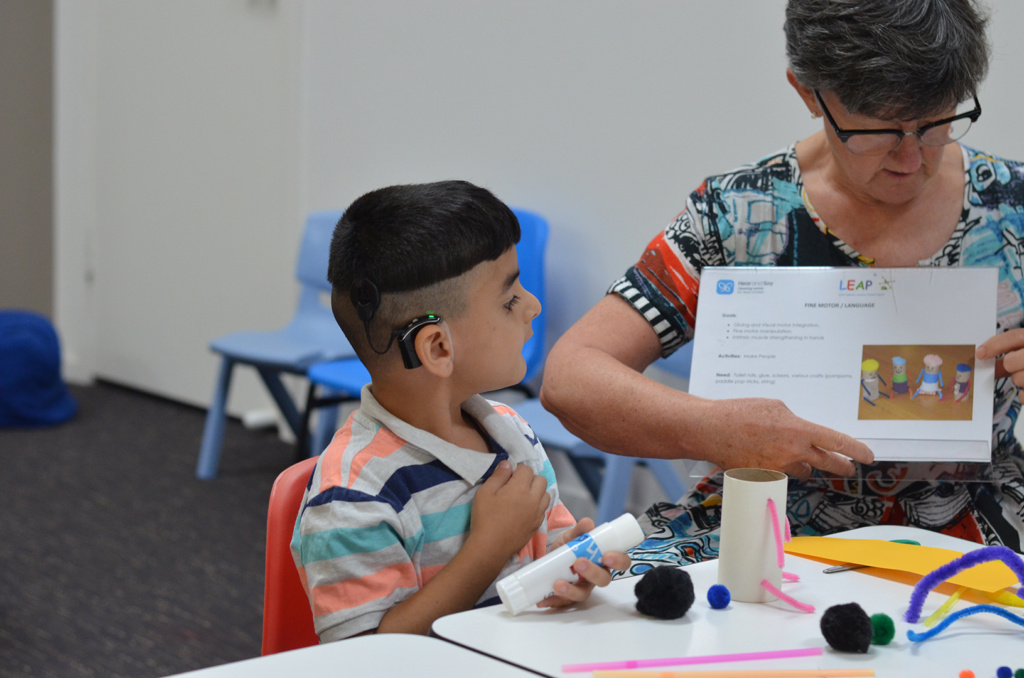
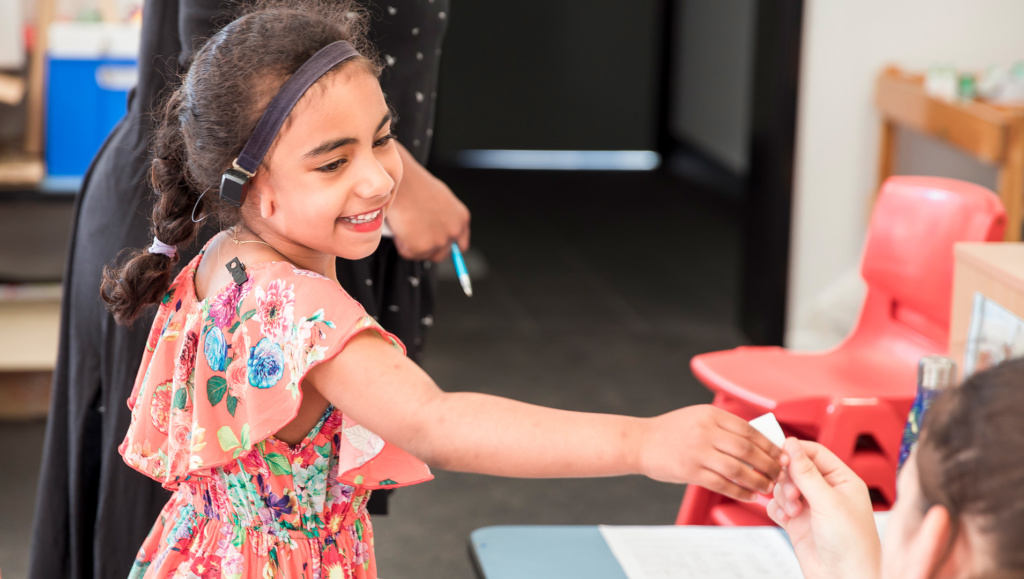
Bone anchored hearing aids
For children with chronic middle ear infections, physical ear abnormalities or issues with the bones in their middle ear, a bone conduction hearing device may be recommended. This device converts sound waves into vibrations that travel through the bones in the skull and middle ear to stimulate hearing structures in the inner ear.
Personal remote microphone systems
Children who use hearing aids or cochlear implants will have difficulty hearing with noise in the background, such as a classroom full of active children. Dynamic remote microphone (or FM) systems can help to reduce this impact of background noise as well as the effects of reverberation and distance from the teacher’s voice.
A teacher’s voice loses 6dB of intensity for every doubling of distance. Personal remote microphone (or FM) systems place the teacher’s voice at ‘the child’s ear’ by transmitting the speech at close range directly into a hearing aid or receiver coupled to a hearing aid or cochlear implant sound processor. The dynamic remote microphone system also manages the amount of background noise picked up by the teacher’s microphone. This ensures the teacher’s voice is suitably loud and clear.
SoundField amplification system
Classrooms can be quite noisy, making it hard for children to hear and fully participate in their learning. Amplification systems, such as the Roger™ SoundField, can connect directly to students’ hearing devices as well as boost the sound of the teacher’s or speaker’s voice for everyone in the room. The SoundField system enhances listening for everyone, resulting in:
- Better hearing conditions
- Improved learning for all students
- Increased attention, interaction and participation
- Less time spent repeating information or instructions
- Reduced need for teachers to raise their voices to be heard
Get in touch for more information
Benefit of communication strategies: Early Intervention program
Together with families and health professionals, our Early Intervention program, through highly specialised speech therapy, strives to teach children who are deaf or hard of hearing to listen and speak and reach their potential in all aspects of development.
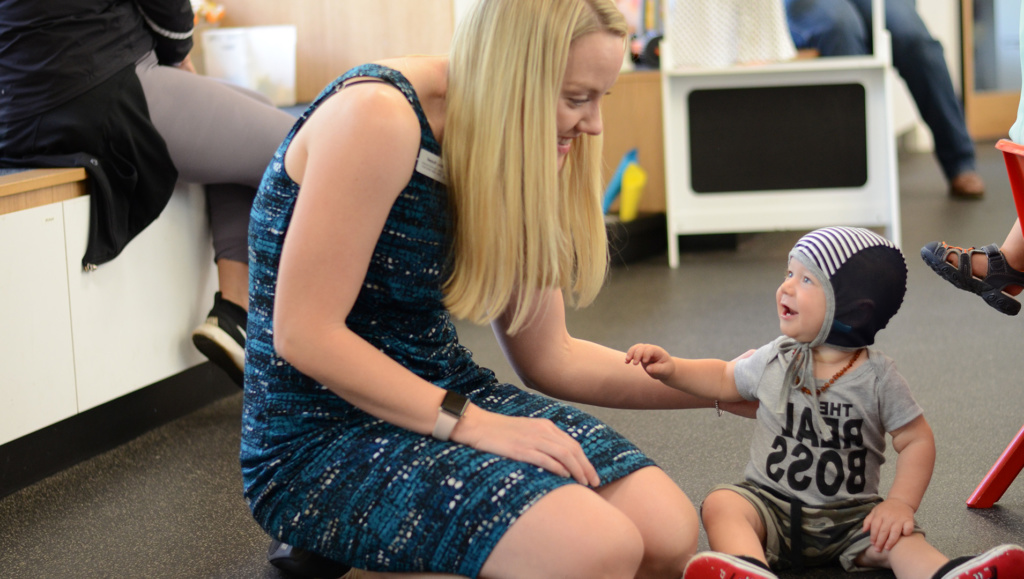
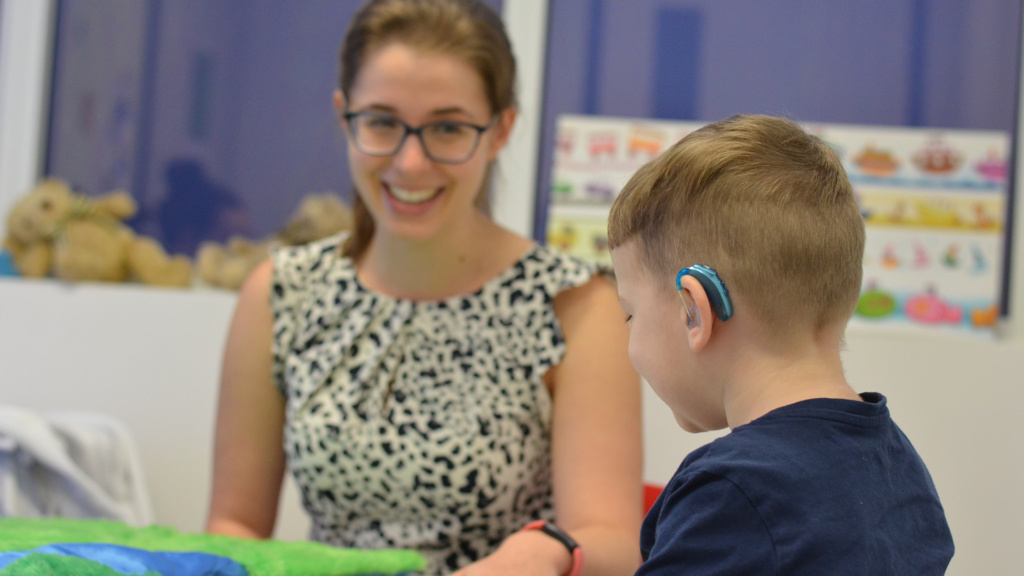
Specialist Speech Therapy
Our expert team of qualified speech pathologists, teachers of the deaf and audiologists work with children and their families to develop children’s speech and language through listening – known as listening and spoken language therapy. This approach follows a child’s natural progression of development in listening, language, speech, literacy, cognition and socials skills.
In conjunction with our qualified audiologists and access to the best possible hearing technology available, therapists guide and coach families to teach their children the skills needed to listen and speak. They help train children’s brains to use their hearing to process speech and learn talk just like others around them.
One-on-one sessions with families, both in-centre and via telehealth, include a variety of age-appropriate strategies, from interactive play to reading books and craft. Families can then carry out these activities in their homes and day-to-day settings.
How it works
- Regular speech therapy lessons (weekly, fortnightly or monthly)
- In-centre or telepractice lessons
- Monitoring and assessment through The Seven Sound Test and otoscopy
- Specialist visits to child’s daycare, kindergarten or school
- Group Social Skills programs for peer mentoring and to foster resilience and wellbeing
- Multidisciplinary team support including audiology, speech pathology, occupational therapy and social work
- Regular parent information webinars
Regular group programs
Join families and practice skills learned in therapy appointments whilst connecting with others in a similar situation.
The impact of hearing loss at school
It’s important to monitor children’s language and literacy to ensure they’re developing at the same rate as their peers. Classrooms in schools can be busy and noisy, especially for kids with hearing loss. This can have significant impact on their learning and can lead to speech and language delays, difficulty learning and the need for increased support.
So that no student falls through the cracks, Hear and Say partners with schools to provide vital hearing screening to ensure students are hearing optimally.
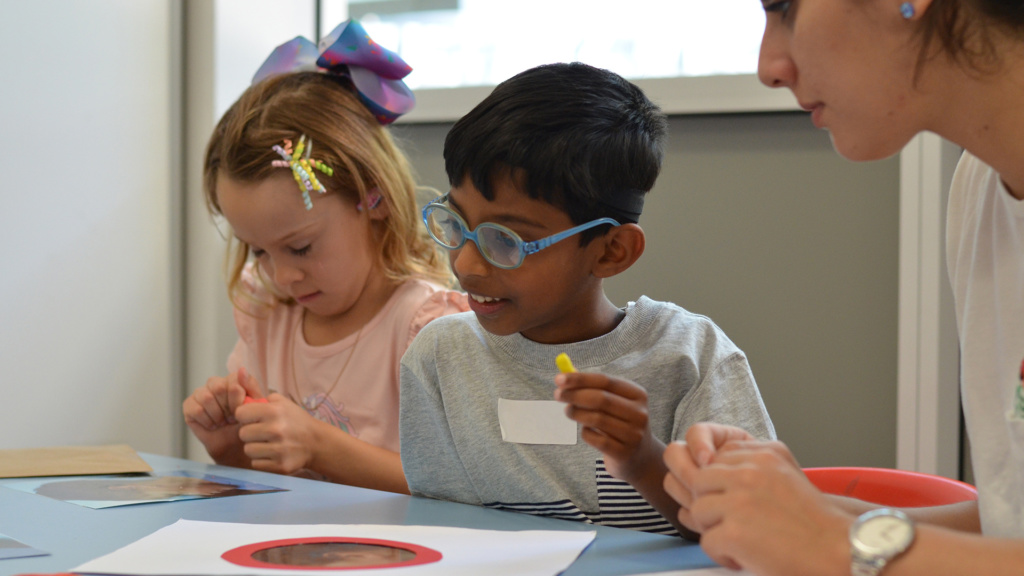
Visits to schools and kindergarten
Hear and Say visits kindergartens, preschools and schools of eligible students with hearing loss through the Special Disability School Support Program. These visits aim to provide information and specialist support for students transitioning into formal schooling.

Online appointments
Regardless of where you live, Hear and Say can support you thanks to videoconferencing technology via telepractice. Families can also access services through a combination of both in-centre and online appointments.
News
Triumphs through speech telehealth
Christmas Gift of Sound for Baby Leo
FAQs
About 300 babies are born in Australia with hearing loss each year,2 and by the time children reach school-age, this number doubles.3,4 There are about 12,000 kids across Australia having hearing loss (three in every 1,000).3,4
Encouraging children to wear their hearing aids or implantable hearing devices (such as cochlear implants) is a challenge many families might experience. We know that maximum benefit from hearing devices can only be achieved if they’re being worn as often as possible, preferably every waking moment.
Sometimes a child’s hearing loss or circumstances may change and therefore the treatment option may change to accommodate this. We encourage you to speak with your therapist or audiologist about options for treatment.
In most cases, the answer is ‘yes’. If a child is eligible for hearing technology to be fitted, and this is fitted at a young age coupled with speech pathology, a child with hearing loss can learn to listen and speak.
If children receive hearing aids or implants at an early age, they will typically sound the same as people around them.
We support families by:
- Drawing on 30 years of experience to help children with hearing loss to learn to listen and speak
- Assisting with navigating the NDIS and support organisations
- Connecting children and families with a network of other parents, kids and alumni who can provide advice and support based on shared experiences.
Yes, Hear and Say specialises in audiology and speech pathology rather than Auslan, so we refer families to similarly specialised organisations to learn Auslan. It is quite common for parents to want their children to be able to listen, speak and sign and we support them with those ambitions.
Listening and spoken language therapy is a specialised discipline that supports children who are deaf and hard of hearing to hear and speak. It focuses on learning through listening, using the best available hearing technology, along with specialised therapy sessions. Parents are natural language teachers for their children, and our approach guides and coaches them how to teach their children the skills to listen and speak.
No, it is common for families to want their child to be able to listen, speak and sign and we support parents and their children with options to achieve those goals. We specialise in audiology and speech pathology however we don’t specialise in Auslan, so we refer families to other organisations that have that expertise.
Hear and Say recognises and respects the importance of Auslan as a language. We also acknowledge that Deaf Culture provides a sense of belonging and cultural affinity for people who are deaf or hard of hearing. Hearing, speaking and signing are not necessarily mutually exclusive.
Most children receive hearing aids or devices like cochlear implants before their first birthday. It is optimal they start learning speech and language development early in life, typically in the first three years. If they don’t start hearing vital sounds in the early months of life, the brain may not establish the neural pathways needed for development.
A child’s hearing journey doesn’t end once hearing aids are fitted or a cochlear implant is switched on. There is a lot of work to be done to develop a child’s hearing and speech in the months and years that follow getting hearing technology. This includes support through therapy and helping parents, teachers and other people in the child’s life.
The children we see typically become very confident communicators. If hearing loss is identified at birth, it is likely that a child will be able to hear and speak at the same level as their peers by the time they enter school, even if they are profoundly deaf.
Our services include listening and spoken language therapy, sub-disciplines of speech pathology, audiology, and services that support broader physical, emotional and social development. We also provide referrals to other organisations for services such as Auslan, physiotherapy, and outside Brisbane, social work and occupational therapy.
Get the latest updates...
Keep up-to-date with our latest news, information, events and more.
"*" indicates required fields
References
1 Fulcher, A., Purcell, A., Baker, E., & Munro, N. (2012). Listen up: children with early identified hearing loss achieve age-appropriate speech/language outcomes by 3 years-of-age. International Journal of Pediatric Otorhinolaryngology, 76(12),1785-94.
2 Queensland Health. (2020). Screening Protocols and Guidelines 2016 V2. https://www.childrens.health.qld.gov.au/wp-content/uploads/PDF/healthy-hearing/2017-newborn-prot-guide.pdf
3 Deloitte Access Economics. (2017). The social and economic cost of hearing loss in Australia. Hearing Care Industry Association. http://www.hcia.com.au/hcia-wp/wp-content/uploads/2015/05/Social-and-Economic-Cost-of-Hearing-Health-in-Australia_June-2017.pdf
4 Australian Bureau of Statistics. (2020). Schools: Data on students, staff, schools, rates and ratios for government and non-government schools, for all Australian states and territories. https://www.abs.gov.au/statistics/people/education/schools/latest-release
ABN 32 058 430 069
Acknowledgement of country
We acknowledge the Traditional Custodians of all the lands on which we meet, work and live, and pay our respect to Elders, past, present and emerging. We respect their continuing culture and the contributions Aboriginal and Torres Strait Islander peoples make through their resilience and strength.
Privacy Policy | Accessibility Statement
Copyright © 2024 – All Rights Reserved
29 Nathan Avenue, Ashgrove Qld 4060 ABN 32058 430 069
Acknowledgement of country
We acknowledge the traditional custodians of all the lands on which we meet, work and live and recognise that this land has always been and always will be Aboriginal and Torres Strait Islander land.
- Privacy Policy
- Contact Us
- Copyright © 2024 - All Rights Reserved

